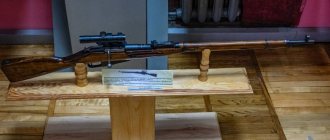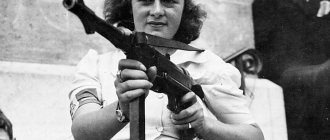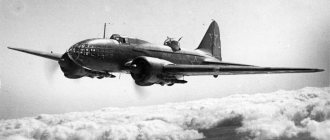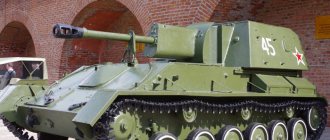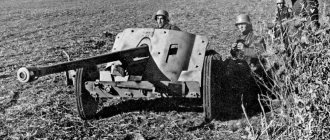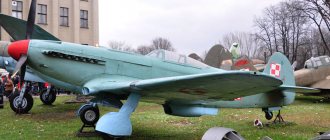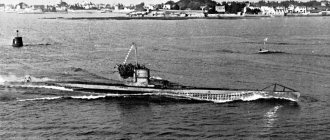By the end of the 30s, almost all participants in the coming world war had formed common directions in the development of small arms.
The range and accuracy of the attack was reduced, which was compensated by the greater density of fire. As a consequence of this, the beginning of mass rearmament of units with automatic small arms - submachine guns, machine guns, assault rifles. Accuracy of fire began to fade into the background, while the soldiers advancing in a chain began to be taught shooting on the move. With the advent of airborne troops, the need arose to create special lightweight weapons.
Maneuver warfare also affected machine guns: they became much lighter and more mobile. New types of small arms appeared (which was dictated, first of all, by the need to fight tanks) - rifle grenades, anti-tank rifles and RPGs with cumulative grenades.
Small arms of the USSR World War II
On the eve of the Great Patriotic War, the rifle division of the Red Army was a very formidable force - about 14.5 thousand people. The main type of small arms were rifles and carbines - 10,420 pieces. The share of submachine guns was insignificant - 1204. There were 166, 392 and 33 units of heavy, light and anti-aircraft machine guns, respectively.
The division had its own artillery of 144 guns and 66 mortars. The firepower was supplemented by 16 tanks, 13 armored vehicles and a solid fleet of auxiliary vehicles.
Rifles and carbines
Three-line Mosin
The main small arms of the USSR infantry units of the first period of the war was certainly the famous three-line rifle - the 7.62 mm S.I. Mosin rifle of the 1891 model, modernized in 1930. Its advantages are well known - strength, reliability, ease of maintenance, combined with good ballistics qualities, in particular, with an aiming range of 2 km.
Mosin Three-Ruler
The Three-Ruler is an ideal weapon for newly recruited soldiers, and the simplicity of the design created enormous opportunities for its mass production. But like any weapon, the three-line gun had its drawbacks. The permanently attached bayonet in combination with a long barrel (1670 mm) created inconvenience when moving, especially in wooded areas. The bolt handle caused serious complaints when reloading.
After battle
On its basis, a sniper rifle and a series of carbines of the 1938 and 1944 models were created. Fate gave the three-line a long life (the last three-line was released in 1965), participation in many wars and an astronomical “circulation” of 37 million copies.
Sniper with a Mosin rifle (with a PE optical sight, model 1931)
SVT-40
At the end of the 30s, the outstanding Soviet weapons designer F.V. Tokarev developed a 10-round self-loading rifle cal. 7.62 mm SVT-38, which after modernization received the name SVT-40. It “lost weight” by 600 g and became shorter due to the introduction of thinner wooden parts, additional holes in the casing and a decrease in the length of the bayonet. A little later, a sniper rifle appeared at its base. Automatic firing was ensured by the removal of powder gases. The ammunition was placed in a box-shaped, detachable magazine.
The target range of the SVT-40 is up to 1 km. The SVT-40 served with honor on the fronts of the Great Patriotic War. It was also appreciated by our opponents. Historical fact: having captured rich trophies at the beginning of the war, among which there were many SVT-40s, the German army... adopted it for service, and the Finns created their own rifle on the basis of the SVT-40 - TaRaKo.
Soviet sniper with SVT-40
The creative development of the ideas implemented in the SVT-40 became the AVT-40 automatic rifle. It differed from its predecessor in its ability to fire automatically at a rate of up to 25 rounds per minute. The disadvantage of the AVT-40 is its low accuracy of fire, strong unmasking flame and loud sound at the moment of firing. Subsequently, as automatic weapons entered the military en masse, they were removed from service.
Submachine guns
PPD-40
The Great Patriotic War was the time of the final transition from rifles to automatic weapons. The Red Army began to fight, armed with a small number of PPD-40 - a submachine gun designed by the outstanding Soviet designer Vasily Alekseevich Degtyarev. At that time, PPD-40 was in no way inferior to its domestic and foreign counterparts.
Designed for a pistol cartridge cal. 7.62 x 25 mm, the PPD-40 had an impressive ammunition load of 71 rounds, housed in a drum-type magazine. Weighing about 4 kg, it fired at a rate of 800 rounds per minute with an effective range of up to 200 meters. However, just a few months after the start of the war, it was replaced by the legendary PPSh-41 cal. 7.62 x 25 mm.
PPSh-41
The creator of the PPSh-41, designer Georgy Semenovich Shpagin, was faced with the task of developing an extremely easy-to-use, reliable, technologically advanced, cheap to produce mass weapon.
PPSh-41
Fighter with PPSh-41
From its predecessor, the PPD-40, the PPSh inherited a drum magazine with 71 rounds. A little later, a simpler and more reliable sector horn magazine with 35 rounds was developed for it. The weight of the equipped machine guns (both versions) was 5.3 and 4.15 kg, respectively. The rate of fire of the PPSh-41 reached 900 rounds per minute with an aiming range of up to 300 meters and the ability to fire single shots.
PPSh-41 assembly shop
To master the PPSh-41, a few lessons were enough. It could easily be disassembled into 5 parts made using stamping and welding technology, thanks to which during the war years the Soviet defense industry produced about 5.5 million machine guns.
PPS-42
In the summer of 1942, the young designer Alexey Sudaev presented his brainchild - a 7.62 mm submachine gun. It was strikingly different from its “bigger brothers” PPD and PPSh-41 in its rational layout, higher manufacturability and ease of manufacturing parts using arc welding.
PPS-42
Son of the regiment with a Sudaev machine gun
PPS-42 was 3.5 kg lighter and required three times less manufacturing time. However, despite its quite obvious advantages, it never became a mass-produced weapon, leaving the PPSh-41 to take the lead.
DP-27 light machine gun
By the beginning of the war, the DP-27 light machine gun (Degtyarev infantry, 7.62mm caliber) had been in service with the Red Army for almost 15 years, having the status of the main light machine gun of infantry units. Its automation was powered by the energy of powder gases. The gas regulator reliably protected the mechanism from contamination and high temperatures.
The DP-27 could only fire automatically, but even a beginner needed a few days to master shooting in short bursts of 3-5 shots. Ammunition of 47 rounds was placed in a disk magazine with a bullet towards the center in one row. The magazine itself was mounted on top of the receiver. The weight of the unloaded machine gun was 8.5 kg. An equipped magazine increased it by almost another 3 kg.
Machine gun crew DP-27 in battle
It was a powerful weapon with an effective range of 1.5 km and a combat rate of fire of up to 150 rounds per minute. In the firing position, the machine gun rested on a bipod. A flame arrester was screwed onto the end of the barrel, significantly reducing its unmasking effect. The DP-27 was serviced by a gunner and his assistant. In total, about 800 thousand machine guns were produced.
For those who want to know more
Over the 72 years that have passed since the end of the Great Patriotic War, many books and articles have been written about the technical equipment of the Soviet Army of those times. But it’s better to watch it once than to read it 10 times.
The largest exhibition of military equipment (300 samples) is presented in an open area next to the Central Museum of the Great Patriotic War on Poklonnaya Hill in Moscow . Even if you don’t have time today, it doesn’t matter, you can visit this place on any other day.
The address, opening hours and information about excursions are on the official website.
( 1 votes, overall rating: 5.00 out of 5)
